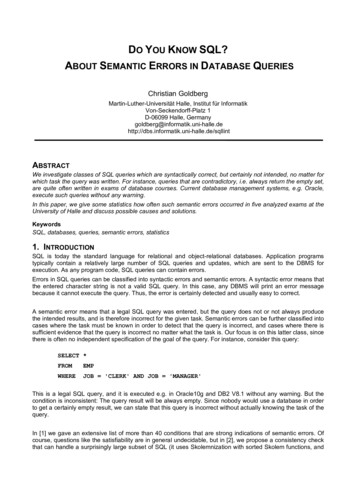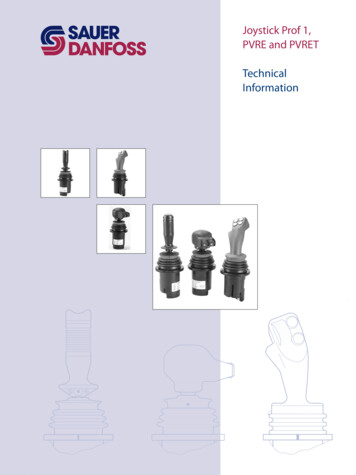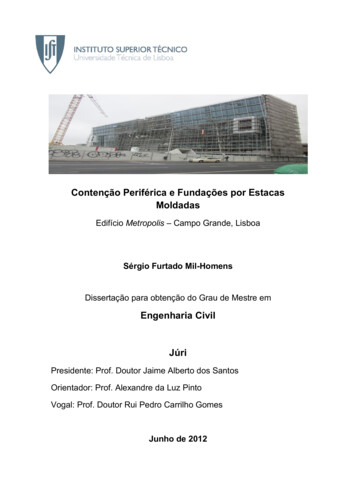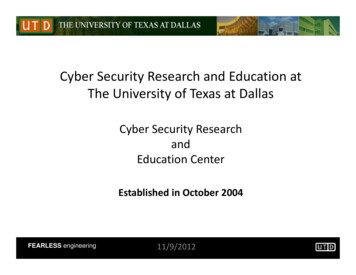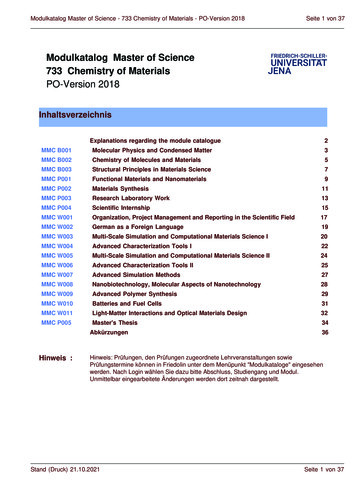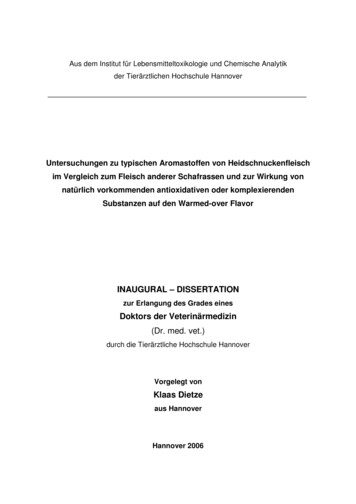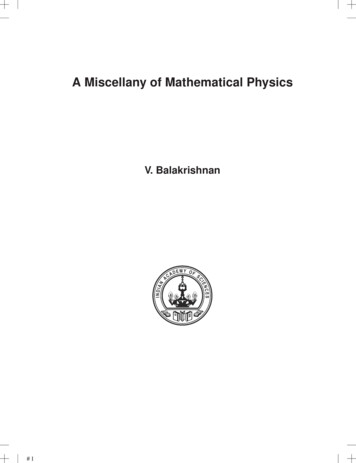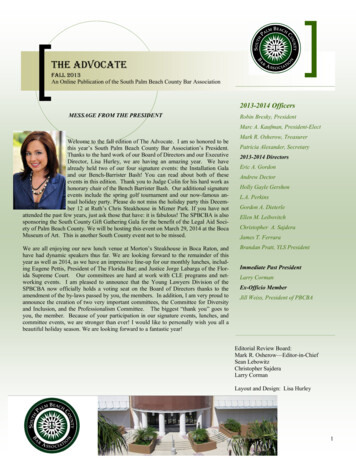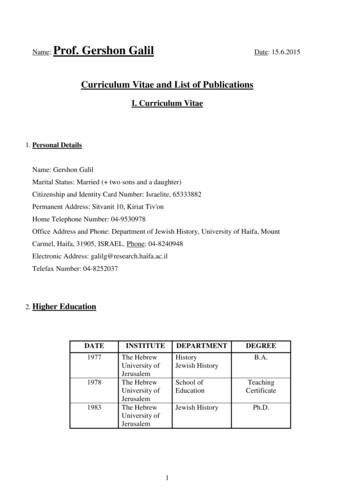
Transcription
Name:Prof. Gershon GalilDate: 15.6.2015Curriculum Vitae and List of PublicationsI. Curriculum Vitae1. Personal DetailsName: Gershon GalilMarital Status: Married ( two sons and a daughter)Citizenship and Identity Card Number: Israelite, 65333882Permanent Address: Sitvanit 10, Kiriat Tiv'onHome Telephone Number: 04-9530978Office Address and Phone: Department of Jewish History, University of Haifa, MountCarmel, Haifa, 31905, ISRAEL. Phone: 04-8240948Electronic Address: galilg@research.haifa.ac.ilTelefax Number: 04-82520372. Higher EducationDATE171117111711INSTITUTEDEPARTMENTThe HebrewUniversity ofJerusalemThe HebrewUniversity ofJerusalemThe HebrewUniversity ofJerusalemHistoryJewish HistorySchool ofEducationJewish History1DEGREEB.A.TeachingCertificatePh.D.
3. Academic Ranks and Tenure in Institutes of Higher he HebrewUniversity ofJerusalemThe HebrewUniversity ofJerusalemUniversity ofHaifa1717-1771University ofHaifa1771-2882University ofHaifa2002-2010University ofHaifaUniversity ofHaifa2011-DEPARTMENTRANKJewish HistoryAssistantJewish HistoryInstructorJewish Historyand Land of IsraelStudiesJewish Historyand Land of IsraelStudiesJewish Historyand Land of IsraelStudiesJewish HistoryBiblical StudiesJewish HistoryBiblical StudiesLecturer(proposed rank)LecturerSenior LecturerAssociateProfessorFull Professor4. Offices in University Academic AdministrationChair of the Department of Jewish History – 2000-2003Member of the tenders committee of the university – 2001 Head of the M.A. program "The Bible and its World" – 2002 –Member of the M.A. committee of the Department of Jewish History – 2003-2006Head, Ruah HaHinuch: The Interdisciplinary Program ofthe Faculty of Education and the Faculty of Humanities – 2012-5. Scholarly Positions and Activities outside the UniversityOffices in Professional AssociationsMember of the scientific committee of Yad Izhak Ben-Zvi, Jerusalem – 2003-2005Member of the scientific committee of Yad Izhak Ben-Zvi, Haifa – 1988 Member of the managing committee of the Israel Societyfor Assyriology and Ancient Near Eastern Studies – 1999-2001, 2005 Member of the committee of Yad Izhak Ben-Zvi Prize, Jerusalem – 2003Chairman of the Israel Society for Assyriology and Ancient Near Eastern Studies – 2011Member of the Israel Prize committee (Biblical Studies) – 2015Referee and Reviewer for Professional Journals, and other Scientific WorksReferee for the journal CATHEDRA – 1997-1998Reviewer for the professional journals: CBQ, Qadmoniot, RBLReader of Ph.D. and M.A. Dissertations – 2000 -2
Membership in Professional AssociationsMember of the Israel Society for Assyriology and Ancient Near Eastern StudiesMember of the World Union of Jewish Studies.Member of the Society of Biblical Literature.Member of ASOR (American Schools of Oriental Research(Active Participation in Scholarly Conferences6a. Conferences in IsraelConferencePlace & DateTitle of Presentation9th World Congress of Jewish StudiesGalilee StudiesJerusalem, 1985Haifa, 198910th World Congress of Jewish Studies11th World Congress of Jewish Studies17th Congress of the Zalman Shazar Centerfor Jewish HistoryJerusalem, 1989Jerusalem, 1993Tel-Aviv, 1993The Stage of the Historian of the ZalmanShazar Center for Jewish History4th Conference of the Israel Society forAssyriology and Ancient Near EasternStudies6th Conference of the Israel Society forAssyriology and Ancient Near EasternStudiesPolemics in the BibleHaifa, 1999Sennacherib's Campaign to the WestGeba‛, Beth-Dagon and the Boundarybetween Asher and ZebulunThe Formation of JudahThe Crystallization of the Book of JoshuaThe Economic Activity of WealthyFamilies in Nineveh in the 8th-7thCenturies B.C.Monogamy and Monotheism in theAncient Near EastSerfs and Slaves in the Neo-AssyrianEmpire14th World Congressof Jewish StudiesIsraelite and Jewish Identity during theBiblical and Second Temple Periods:Tribalism, Nationhood and ReligionThe Manasseh Hill-Country SurveyJerusalem, 2005Leaders and Leadership in Jewish CultureHaifa, 2009The Age of Monarchy in IsraelBar Ilan,2009Jerusalem, 200915th World Congressof Jewish StudiesThe Bible in Light of Modern ResearchThe Book of ChroniclesTHE ANCIENT NEAR EAST IN THE 12th10TH CENTURIES BCE: CULTURE ANDHISTORYHaifa, 2001Jerusalem, 2003* Disorder and Corruption in the NeoAssyrian EmpireHaifa, 2004* Polemics and Propaganda in theDeuteronomistic History* The Rise and Fall of two RegionalEmpires* Judean Identityat the Beginning of theMonarchic AgeBar Ilan,2008Haifa, 2008Haifa, 2009Bar Ilan, 2010Haifa, 20101* Polemics and Propaganda in BiblicalHistoriography* Charisma and Imperialism in Israel andin the Ancient Near East* The Book of Samuel: Formation andHistorical ReliabilitySolomon's Temple:Fiction or RealityHezekiah in the Maelstrom betweenSennacherib and ShabatakaRetribution in ChroniclesThe Hebrew Inscription from KhirbetQeiyafa/Neta'im: Script, Language,Literature and History
A conference in honour of Prof. RaineyNew Studies on JerusalemBar Ilan, 2010Bar Ilan, 2010The Kingdom of David and Solomon inlight of new Epigraphic and ArchaeologicalDataNew Studies on JerusalemHaifa, 2012Israel Academy of Sciences - Conference inHonor of Jacob KleinNew Studies on JerusalemJerusalem,2014Bar Ilan, 2014Bar Ilan, 2013The Book of JoshuaKing David's first decade as king ofJerusalem and his relations with thePhilistines in light of the Qeiyafaexcavation and inscriptionThe Kingdom of Palestin in light of newEpigraphic and Archaeological Data"yyn hlq": The Most Ancient HebrewInscription from JerusalemThe Rise and Fall of the Kingdom ofPalestin/PatinJerusalem , Hamath and Philistine Gathin the 10th Century BCE6b. Conferences in Europe and USAConference39th Rencontre AssyriologiqueInternationale: Assyrien im Wandelder Zeiten44th Rencontre AssyriologiqueInternationale: Landscapes,Territories, Frontiers and Horizons inthe Ancient Near East52th Rencontre AssyriologiqueInternationale: Krieg und Frieden imAlten VorderasienSociety of Biblical Literature, 2007International MeetingSociety of Biblical Literature, 2009International MeetingLV – Rencontre AssyriologiqueInternationale: The Family in theAncient Near East: Realities,Symbolisms and ImagesVIIIe Colloque International surLa Transeuphratène à l’époque perse:crises et autres difficultésVIIIe Colloque International surLa Transeuphratène à l’époque perse:crises et autres difficultésThe Ancient Near East in the 12th-10thCenturies BCE: Culture and History 2010 International MeetingOxford Senior Old Testament Seminarof the Faculty of Theology of theUniversity of Oxford,INVITEDPlace & DateHeidelberg,1992Title of PresentationConflicts between Assyrian VassalsVenice,1997The Boundaries of Aram-DamascusMünster, Germany,2881David and Hazael: War, Peace, Stones andMemoryVienna, 2007Israelite Exiles in Media: A New Look atND 2443Appropriation of Land by Officials in theNeo-Assyrian PeriodThe Family in theNeo-Assyrian PeriodRome, 2009Paris, 2009Paris,April 2010Paris,April 2010HaifaMay 2010OxfordMay 20104The Script and the Language of theHebrew Inscription from KhirbetQeiyafa/Neta'im“The secret things belong to the Lord ourGod” (Deut 29:29): Retribution in thePersian PeriodThe Hebrew Inscription from KhirbetQeiyafa/Neta'im: Script, Language,Literature and HistoryThe Khirbet Qeiyafa inscription and itsimplications for Biblical studies
Anglo-Israel Archaeology SocietyLectures - Jointly with King's CollegeUniversity of London,INVITEDResearch group: Schriftbildlichkeit:Über Materialität, Wahrnehmbarkeit,und Operativität von Notationen,Freie Universität, Berlin, INVITEDDavid and Solomon betweenText and Material CultureThe Faculty of the Graduate School ofVanderbilt University, INVITEDSociety of Biblical Literature –2010 Annual Meeting,INVITEDSociety of Biblical Literature –2010 Annual Meeting – AtlantaSociety of Biblical Literature –2010 Annual Meeting – AtlantaASOR SBL - Current Issues inBiblical Archaeology- - INVITEDLondonMay 2010BerlinNovember 2010New York16 r2010AtlantaNovemberAtlantaNovemberAtlantaNovember 2010The Khirbet Qeiyafa inscription and theKingdom of David and SolomonWriting and Scribes in Southern Levant inthe 10th Century BCEYeshiva UniversityThe Qeiyafa Inscription: Script, Language,Epic and HistoryConnections between Judges, Samuel,Kings and the Qeiyafa InscriptioThe Status of The Lower Stratum Familiesin the Neo-Assyrian PeriodSolomon's temple: Fiction or RealityKing David's first decade as king ofJerusalem and his relations with thePhilistines in light of the Qeiyafaexcavation and inscription6c Membership in organizing committees of scientific conferencesMember of the organizing committee of the Fourth Conference of the IsraelSociety for Assyriology and Ancient Near Eastern Studies – Haifa, 2001Member of the organizing committee of the Conference: Polemics in the Bible University of Haifa, 2001Member of the organizing committee of the Ninth Conference of the IsraelSociety for Assyriology and Ancient Near Eastern Studies – Haifa, 2006Chair of the organizing committee of the International Conference:THE ISRAELITES AND THEIR NEIGHBOURS IN THE 12th-10TH CENTURIES BCE: CULTUREAND HISTORY – University of Haifa – 2-5 May 2010Chair of the organizing committee of the 14th Conference of the IsraelSociety for Assyriology and Ancient Near Eastern Studies – Haifa, 2011:History and Historiography in The Ancient Near EastOrganizer of the Conference : The Kingdom of David and Solomon in light of newEpigraphic and Archaeological Data (Haifa, 2012)5
6. Colloquium TalksConferencePlace & DateTitle of Presentation3rd Israel-Canada Conference on SocialScientific Approachesto the Study of JudaismThe Bible, Israel andthe Ancient Near EastA Congress in honor of Prof. M. WeinfeldBar-IlanUniversity, 1991The Israelite Society in BiblicalTimesHaifa, 1996Galilee 2000The Book of RuthBar-IlanUniversity, 2000Haifa, 2004Daily Life in Biblical TimesHaifa, 2005The Seminar of the Department of JewishHistoryDeuteronomy and the DeuteronomisticHistoryThe Seminar of the N. S. Kramer Instituteof AssyriologyThe Bible and the Ancient Near EasternMythHaifa, 2005The Reliability of the Book ofChroniclesThe Composition of the Book ofKings and the DeuteronomisticHistoryThe Galilee between Israel andAram-DamascusInheritance by Widows in Israeland in the Ancient Near EastThe Book of Jeremiah:The Epilog of the DeuteronomisticHistoryThe Everlasting LoveBoundaries and Boundary Disputes in theAncient Near EastBen-GurionUniversity, 2007Past, Present and Future in theDeuteronomistic HistoryPrivate Commerce in theNeo-Assyrian PeriodThe Socio-economic Status of theWidows in Israel and in the AncientNear EastForbidden Boundaries: Ideologyand RealityRoutes, Trade and Cultural Influence –Bronze – Iron AgesThe Seminar of the Department of Bibleand Ancient Near Eastern Studies13th Conference of the Israel Society forAssyriology and Ancient Near EasternStudiesCulture and History in Biblical Times:Current StudiesYad Ben- Zvi,Jerusalem, 2007Ben-GurionUniversity, 2009Bar-IlanUniversity,2010Haifa, 2010Private Commerce in theNeo-Assyrian PeriodThe Society in the Neo-AssyrianPeriodPatronage and Dependence theNeo-Assyrian Period: Socioeconomic AspectsIsraelite Culture: Current StudiesHaifa, 1999Ben-GurionUniversity, 2005Bar-IlanUniversity, 2006Haifa, 20068. Scholarships, Awards, Research Grants* M. Hephetz Prize – The Hebrew University of Jerusalem - 1978* Sank Prize for Biblical Studies – The Hebrew University of Jerusalem - 1981* Bahat Prize – University of Haifa – 2000.* Invitation to the Institute for Advanced Studies,The Hebrew University, Jerusalem – 2009.1
9.TeachingA. Courses taught in recent years:TitleDateType and LevelCulture and Society in Biblical TimesStudies in Biblical HistoriographyCanaan and Israel in the SecondMillennium B.CKings and Prophets: Israel and Judah inthe Monarchic PeriodIsrael in Biblical Times: Culture andHistory2010201420142014Seminar, M.A.Seminar, M.ALecture, B.A.Lecture, B.A.2815Research Seminar (PH. D.)B. Supervision of graduate students in recent years:Student’s NameTitle of Thesis / DissertationDegree and DateNehama GabrielThe Supervisor of the Palace(" ("אשר על הבית in Israel and JudahThe term "Betulah" in the Bible and in the AncientNear EastThe Size and Structure of the Family in UgaritM.A. 2008Economic Activities of Women in the NeoAssyrian PeriodThe Role of the Chariot in the Battlefield of theLate Bronze and Iron Ages (with D. Kahan)Human Rights in Biblical TimesThe Book of JudgesThe Book of Genesis: Structure and FormationThe Socio-Economic Status of Women in Emar(with Yoram Cohen, Tel Aviv University)Slaves and Strangers in Temples and in the PalatialSector in Biblical TimesThe Formation of the Book of JudgesThe Socio-Economic Status of Women in the NeoAssyrian PeriodReforms in Israel and Assyria (with Yairah Amit,Tel Aviv University)Psychological Warfare in Israel and in the AncientNear EastIndividual Laments in the Book of PsalmsBlindness and blind people in Israel and the AncientNear EastEspionage and Spies in Israel and the Ancient NearEastTime and Space in the Book of SamuelM.A. 2007Varda ErlichNeomi Regeb -AkermanTali Leon-NisimAsaf WahllBnayahu BrunerYuval Vad'iIlan sheferNeomi Regeb-AkermanBnayahu Bruner Yuval Vad'iTali Leon-NisimRachel GlauberAsaf WahllGabi BarshiMoshe ZehaviZion Ben EzraSamuel Chaushu1M.A. 2001M.A. 2002M.A. 2007M.A. 2012M.A. 2012Ph.D. 2013Ph.D. In preparationPh.D. In preparationPh.D. In preparationPh.D. In preparationPh.D. In preparationPh.D. In preparationPh.D. In preparationM.A. In preparationM.A. In preparationM.A. In preparation
II PUBLICATIONA. Ph.D. DISSERTATIONThe Genealogies of the Tribe of Judah, The Hebrew University of Jerusalem 1983, pp. 354 xxxv. Supervisor: Prof. Z. Kallai (Hebrew)B. BOOKSAUTHORED BOOKSPUBLISHED1. The Book of Joshua. A Critical Commentary on the Book of Joshua, with an Introduction(in collaboration with Y. Zakovitz; Olam Hatanach), Jerusalem – Tel Aviv (Davidson-Atai)1994, 224 pp. (Hebrew)2. The Book of I Chronicles. A Critical Commentary on the Book of Chronicles, with anIntroduction (in collaboration with M. Garsiel, M. Kochman and Y. Amit; Olam Hatanach),Jerusalem-Tel Aviv (Davidson-Atai) 1995, 288 pp. (Hebrew)3. The Chronology of the Kings of Israel and Judah, Leiden – New York – Köln,(Brill) 1996, (SHCANE 9) XIX 180 pp.4. Israel and Assyria, Haifa - Tel Aviv (Haifa University Press and Zmora-Bitan) 2001,184 pp. This book was awarded the BAHAT PRIZE, 2000 (the first prize).5. The Lower Stratum Families in the Neo-Assyrian PeriodLeiden – Boston (Brill) 2007, xviii 403 pp.Series: Culture and History of the Ancient Near East 27.EDITED BOOKS1-24. Editor and Coordinator of Olam Hatanach: A Critical Commentary of theBible: 24 volumes, Jerusalem-Tel Aviv (Davidson-Atai) 1983–1996, 5754 pp. (Hebrew)25. J. Wellhausen, The Judean Clanss and Families ( De Gentibus et Familiis Judaeis):Preface, Notes and Translation from the Latin (in collaboration with L. Ulmann) Jerusalem(The Dinur Center) 1985, pp. 10 44 45* (Hebrew).26. Studies in Historical Geography and Biblical Historiography presented to ZechariaKallai, G. Galil and M. Weinfeld (eds.), Leiden (Brill) 2000( Supplement to Vetus Tesatamentum, LXXXI), 280 pp.27. Homeland and Exile: Biblical and Ancient Near Eastern Studies in Honour ofBustenay Oded, G. Galil, M. Geller and A. Millard (eds.), Leiden – Boston,(Brill) 2009 ( Supplement to Vetus Tesatamentum, CXXX), xxiv 643 pp.28. The Ancient Near East in the 12th-10th Centuries BCE: Culture and History,G. Galil, et al (eds.), (Ugarit-Verlag), Münster 2012 ( AOAT 392), xviii 647 pp.1
C. ARTICLES IN REFEREED JOURNALSPUBLISHED1. The Administrative Districts of the Judean Hill Area, Zion, 49 (1984), pp. 205–224(Hebrew).2. The Sons of Judah and the Sons of Aaron in Biblical Historiography, VetusTestamentum, 35 (1985), pp. 488–495.2a. Pristhood and Kingship in the Genealogy of the House of Aaron, Beth Miqra,30 (1984), pp. 168–172 (Hebrew).3. The Land of Dan, Tarbitz, 54 (1984), pp. 1–19 (Hebrew).4. The Administrative Division of the Shephelah, Shnaton: An Annual forBiblical and Ancient Near Eastern Studies, 9 (1985), pp. 55–71 (Hebrew).5. Sennacherib Versus Hezekiah: A New Look at the Assyrian Campaign to the West in 701BCE, Zion, 53 (1988), pp. 1–12 (Hebrew).6. The Pre-Davidic Period in Chronicles, Zion, 55 (1990), pp. 1–26 (Hebrew).7. Geba‛, Beth-Dagon and the Boundary between Asher and Zebulun, Cathedra,57 (1990), pp. 3–18 (Hebrew).8. The Chronicler's Genealogies of Ephraim, Biblische Notizen,56 (1991), pp. 11–14.8a. The Genealogy of Ephraim in I Chronicles 7, Beth Miqra,,36 (1991), pp. 139–143 (Hebrew)9. A New Look at the Cronology of the Last Kings of Judah, Zion, 56 (1991), pp. 5–19(Hebrew).9a. The Babylonian Calendar and the Chronology of the Last Kings ofJudah, Biblica, 72 (1991), pp. 367–378.10. Pirathon, Timnatha and the Fortifications of Bacchides, Cathedra, 63 (1992),pp. 22–30 (Hebrew).10a. Pirathon, Parathon and Timnatha, Zeitschrift des DeutschenPalästina-Vareins, 109 (1993), pp. 49–53.11. Judah and Assyria in the Sargonid Period, Zion, 57 (1992), pp. 111–133 (Hebrew).12. Geba‛-Ephraim and the Northern Boundary of the Kingdom of Judah in theDays of Josiah, Tarbitz, 61 (1992), pp. 1–13 (Hebrew).7
12a. Geba‛-Ephraim and the Northern Boundary of Judah in the Days ofJosiah, Revue biblique, 100 (1993), pp. 358–367.13. Conflicts between Assyrian Vassals, State Archives of AssyriaBulletin,6 (1992), pp. 55–63.14. The Last Years of the Kingdom of Israel and the Fall of Samaria,The Catholic Biblical Quarterly, 57 (1995), pp. 52–65.15. New Look at the "Azekah Inscription", Revue biblique, 102 (1995), pp. 321–329.16. The Chronological Data in the Greek Text of Kings, Shnaton: An Annual forBiblical and Ancient Near Eastern Studies, 11 (1996), pp. 56–77 (Hebrew).17. The Canaanite City States in the 14th Century BCE, Cathedra, 84 (1997), pp.7–52 (Hebrew).18. Ashtaroth in the Amarna Period, Israel Oriental Studies, 18 (1998),pp. 373–385.19. A New Look at the Inscriptions of Tiglath-Pileser III, Biblica, 81 (2000), pp.511–520.20. The Historical Context of Judah 19: 40–48, Biblische Notizen,104 (2000), pp. 11–15.21. A Re-arrangement of the Fragments of the Tel Dan Inscription and theRelations between Israel and Aram, Palestine Exploration Quarterly, 133 (2001),pp. 16–21.21a. The Tel Dan Inscription, in: Z. Talshir et al. (eds.), Homage to Samuel: Studies in theWorld of the Bible, Jerusalem 2001, pp. 67–74 (Hebrew).22. The Massage of the Book of Kings in Relation to the Deuteronomyand Jeremiah, Bibliotheca Sacra, 158 (2001), pp. 406–414.22a. The Message of the Book of Kings and the Deuteronomistic History, in: M. Heltzer andM.Malul (eds.), Teshûrôt LaAvishur: Studies in the Bible and the Ancient Near East, inHebrew and Semitic Languages. Festschrift Presented to Prof. Yitzhak Avishur on theOccasion of his 65th Birthday, Tel Aviv – Jaffa 2004, pp. 179–184 (Hebrew).23. The Jerahmeelites and the Negeb of Judah, The Journal of theAncient Near Eastern Society, 28 (2001), pp. 33–42.24. Shalmaneser III in the West, Revue biblique, 109 (2002), pp. 40–56.25. The "Synchronistic History" and the Book of Chronicles: Reconsidering theReliability of Ancient Near Eastern Texts, Henoch, 26 (2004), pp. 136–144.18
26. The Chronological Framework of the Deuteronomistic History,Biblica, 85 (2004), pp. 413–421.27. David and Hazael: War, Peace, Stones and Memory,Palestine Exploration Journal 139 (2007), pp. 79–84.27a. The Rise and Fall of Two Regional Empires, SHNATON: An Annual for Biblical andAncient Near Eastern Studies 17 (2007), pp. 135–146 (Hebrew)28. Financing of Private Commercial Enterprises in the Neo-Assyrian Period:KAV 121 and other Related Texts from Aššur, State Archives of AssyriaBulletin, 15 (2006), pp. 21–41.29. Israelite Exiles in Media: A New Look at ND 2443 , Beth Miqra (NS)52 (2007), pp. 41–60 (Hebrew).29a. Israelite Exiles in Media: A New Look at ND 2443 , Vetus Testamentum59 (2009), pp. 71–79.30. International Private Commerce in the Neo-Assyrian Period, Eretz Israel, 29 (2009), pp.92–99 (Hebrew).31. Forbidden Boundaries: Ideology and Reality, Beer Sheva, 19 (2010),pp. 71–91 (Hebrew).12. The Hebrew Inscription from Khirbet Qeiyafa/Neta'im: Script, Language, Literature andHistory, Ugarit-Forschungen, 41 (2009) [2010], pp. 193–242.33. David, King of Israel, between the Arameans and the Northern and Southern Sea Peoplesin Light of New Epigraphic and Archaeological Data Ugarit-Forschungen, 44 (2013), pp.159–174.34. "‘yyn ḫlq’ The Oldest Hebrew Inscription from Jerusalem", Strata: Bulletin of the AngloIsrael Archaeological Society, 31 (2013), pp. 5–26.35. "A Concise History of Palistin/Patin/Unqi/ʿmq in the 11th–9th Centuries BC", Semitica56 (2014), pp. 75–104.ACCEPTED FOR PUBLICATION36. More Neo-Assyrian Families, State Archives of Assyria Bulletin, – 19 pp. -forthcomingD. ARTICLES OR CHAPTERS IN BOOKS WHICH ARE NOTCONFERENCE PROCEEDINGSPUBLISHED1. The Historical Reliability of the Book of Chronicles, in: Y. Avishur and R. Deutsch (eds.),Michael: Historical, Epigraphical and Biblical Studies in Honor of Prof. Michael Heltzer,Tel Aviv – Jaffa 1999, pp. 55*–62* (Hebrew).11
2. The Boundaries of Aram-Damascus, in: G. Galil and M. Weinfeld (eds.), Studies inHistorical Geography and Biblical Historiography presented to Zecharia Kallai, Leiden,2000 ( Supplement to Vetus Testamentum, LXXXI), pp. 35–41.3. The Formation of I Chr 2:3–4:23 and the Election of King David,in: Y. Sefati, P. Artzi, Ch. Cohen, B.L.Eichler and V.A.Hurowitz(eds.), An Experienced Scribe who neglects nothing, AncientNear Eastern Studies in Honor of Jacob Klein, Bethesda, MD 2005,pp. 707–717.4. A New Look at a Neo-Assyrian sale of "Land and People", in:M. Cogan and D. Kahn (eds.), Treasures on Camel's Humps:Historical and Literary Studies presented to Israel Eph'al,Jerusalem 2008, pp. 75-85.5. Polemics and Propaganda in the Deuteronomistic History, in: S. Bar (ed.), In the HillCountry, and in the Shephelah, and in the Arabah (Joshua 12, 8): Studies andReseaerches Presented to Adam Zertal in the Thirties Anniversary of the Manasseh HillCountry Survey, Jerusalem 2008, pp. 239–247 (Hebrew).6. The Formation of the Clan of Hur, in: S. Vargon et al. (eds.), Studies in Bible andExegesis, 8 (2009), pp. 409–425 (Hebrew).7. Appropriation of Land by Officials in the Neo-Assyrian Period,In: G. Galil, M. Geller and A. Millard (eds.), Homeland and Exile: Biblical and AncientNear Eastern Studies in Honour of Bustenay Oded, Leiden – Boston 2009 ( Supplementto Vetus Tesatamentum, CXXX), pp. 95–119.8. Time and Memory in the Deuteronomistic History, in: M. Garsiel et al. (eds.), Studies inBible and Exegesis, 10 (2009), pp. 179–195 (Hebrew).9. Dates and Calendar in Kings, in: A. Lemaire and B. Halpern (eds.),(Supplements to The Books of Kings: Sources, Composition, Historiography and ReceptionVetus Testamentum), Leiden – Boston 2010, pp. 427–443.10. Polemics and Propaganda in the Deuteronomistic Composition, in G. B. Lanfranchi, D.M. Bonacossi, C. Pappi, and S. Ponchia (eds.), Leggo! Studies Presented to Frederick MarioFales on the Occasion of His 65th Birthday, Wiesbaden (Harrassowitz Verlag) 2012,pp. 293–306 (Enlarged and Augmented version of D / 5)11. The Socio-economic Status of the People enumerated in Sales of "Land and People" inthe Neo-Assyrian Period, in K. Abraham and J. Fleishman (eds.), Looking at the AncientNear East and the Bible Through the same Eyes: A Tribute to Aaron Skaist, Bethesda MD(CDL Press) 2012, pp. 221-236.12. Solomon's Temple: Fiction or Reality?, in G. Galil et al (eds.), The AncientNear East in the 12th-10th Centuries BCE: Culture and History, Münster 2012,pp. 137-148.12a. Solomon's Temple: Fiction or Reality?, in M. Avioz et al. (ed.), ZerRimmonim. FS Rimmon Kasher, Atlanta, 2013, pp. 117-131 (Hebrew).12
13. "The Kingdom of Patin in the 9th Century BC" Transeuphratène 45 (2014), pp. 27-41.ACCEPTED FOR PUBLICATION14. The History of the Land of Israel from the Beginning of History to theBabylonian Period, in: Y. Ben Arieh (ed.), The Land of Israel, pp. 68 (Hebrew).E. ARTICLES IN CONFERENCE PROCEEDINGSPUBLISHED1. The Formation of Judah, Proceedings of the Tenth World Congress of Jewish Studies,Division A, The Bible and its World, Jerusalem 1990, pp. 1–8 (Hebrew).2. The Crystallization of the Book of Joshua, Proceedings of the Eleventh World Congressof Jewish Studies, Division A, The Bible and its World, Jerusalem 1994, pp. 47–53(Hebrew).3. The Economic Activity of Wealthy Families in Nineveh in the8th and 7th Centuries BCE, in: I. Bartal and I. Gafni (eds.), Sexuality andthe Family in History, Jerusalem 1998, pp. 27–41 (Hebrew).4. The Galilee between Israel and Damascus, in: Z. Safrai (ed.), Galilee Studies,Ramat-Gan 2009, pp. 26–36 (Hebrew).5. King David's First Decade as King of Jerusalem and his Relations with the Philistines inLight of the Qeiyafa Excavations and Inscription, in: E. Baruch, A. Levy-Reifer and A. Faust(eds.), New Studies on Jerusalem – Volume 16, Ramat-Gan 2010, pp. 21–71 (Hebrewversion of C32).6. "The secret things belong to the Lord our God" (Deut 29: 29): Retribution in the PersianPeriod, Transeuphratène 39 (2010), pp. 89–94.7. Retribution in the Book of Chronicles, in: M. Gruber et al (eds.), TESHURA LEZAFRIRA: Studies in the Bible, the History of Israel and the Ancient Near East, Presentedto Zafrira Ben-Barak),Beer Sheva 2012, pp. 109-117.8. "yyn hlq": The Most Ancient Hebrew Inscription from Jerusalem, in: E. Baruch, A.Levy-Reifer and A. Faust (eds.), New Studies on Jerusalem – Volume 19, Ramat-Gan2013, pp. 21–71 (Hebrew version of C34).9. Jerusalem , Hamath and Philistine Gath in the 10th Century BCE, in: E. Baruch, A.Levy-Reifer and A. Faust (eds.), New Studies on Jerusalem – Volume 20, Ramat-Gan2014, pp. 21–71 (Hebrew version of C32)10. The Rise and Fall of the Kingdom of Palestin/Patin in light of new Epigraphic anArchaeological Data, in M. Cogan (ed.), A volume in Honor of Jacob Klein (Israel Academyof Sciences; Hebrew version of C35) – 45 pp.11
F. OTHER SCIENTIFIC PUBLICATIONSNOTESPUBLISHED1. Two Neo-Assyrian Tablets from Tel Hadid, Nouvelles Assyriologiques Breveset Utilitaires, 2001/3, pp. 68–69.2. ADD 79 ( SAA XIV 209) reconsidered, NouvellesAssyriologiques Breves etUtilitaires, 2006/1, no. 02, p. 2.REJOINDERSPUBLISHED1. The Administrative Division of the Kingdom of Judah in Light of the Epigraphical Data,Zion, 52 (1987), pp. 495–509 (Hebrew).2. On the use of Epigraphical Sources for the Study of Biblical History, Zion, 53 (1988), pp.214–216 (Hebrew).BOOK REVIEWPUBLISHED1. Who wrote the Book of Joshua, HAARETZ, July 5, 1996, pp. 5, 26 (Hebrew).2. M. C. Tetley, The Reconstructed Chronology of the Divided Kingdom (Winona Lake, IN:Esenbrauns, 2005), pp. xiv 194, The Catholic Biblical Quarterly, 68 (2006), pp. 131–133.3. S. Ahituv, Haktav VeHaMiktav, Jerusalem 2005, 465 pp., Qadmoniot, 39 (2006), pp. 126–127 (Hebrew)4. R. W. Klein, 1 Chronicles: A Commentary (Hermeneia: A critical and HistoricalCommentary on the Bible; Minneapolis, MN: Fortress Press, 2006), xxi 561 pp.,Review of Biblical Literature, 5/2007, pp. 1–4.5. S. M. Paul, Isaiah 40–66: Introduction and Commentary (Mikra LeyIsra'el). I–II, Tel-Avivand Jerusalem 2008, xvi 619, pp HAARETZ, 10.6.2008, p. 4 (Hebrew).6. B. FAIST, Alltagstexte aus neuassyrischen Archiven und Bibliotheken der StadtAssur,. Studien zu den Assur-Texten, vol. 3. Wiesbaden: HARRASSOWITZ VERLAG, 2007. xx 250, pp., plates, Journal of the American Oriental Society, 128 (2008), pp. 7–8.7. J. T. Sparks, The Chronicler’s Genealogies: Towards anUnderstandingof 1 Chronicles 1–9, Society of Biblical Literature Academia Biblica 28,Atlanta: Society of Biblical Literature, 2008. xvi 385, pp., Review of Biblical Literature,7/2009, pp. 1–7.14
8. The Early Monarchic Age in Israel: a review-article of M. Garsiel, The Rise of theMonarchy in Israel: Studies in the Book of Samuel, The Open University of Israel, 4 vols.,Raanana, Israel 2008, Beth Miqra (NS) 54 (2009), pp. 172–181 (Hebrew).9. The Book of Chronicles: Literature. Historiography and Theology: a review-article of I.Kalimi, The Reshaping of Ancient Israelite History in Chronicles, Winona Lake, IN:Eisenbrauns, 2005, xiii, 473 pp., Mo'ed: Annual for Jewish Studies 20 (2010), pp. 299-309(in collaboration with S. Cohen) – (Hebrew).10. F. M. Fales, Guerre et paix en Assyrie: Religion et impérialisme, Les Conférences del'École pratique des hautes etudes 2 Paris: Cerf, 2010, 246 pp., Review of Biblical Literature,3/2011, pp. 1-10.11. M. Cogan, The Raging Torrent: Historical Inscriptions from Assyria and BabyloniaRelating to Ancient Israel, Carta, Jerusalem 2008, xiv 250 pp. Israel Exploration Journal,61 (2011), pp. 117-120.12. Z. Kallai, Studies in Biblical Historiography and Geography: Collection of Studies(Beiträge zur Erforschung des Alten Testaments und des Antiken Judentums 56), Peter Lang,Frankfurt am Main, 2010. 262 pp. Israel Exploration Journal, 61 (2011), pp. 240-242.G. ENTRIES IN ENCYCLOPEDIA OR DICTIONARYPUBLISHED1. Dozens Entries in Olam Hatanach: A Critical Commentary of the Bible, 24volumes, Jerusalem–Tel Aviv (Davidson-Atai) 1983–1996 (Hebrew).2. The Land of Israel in the Monarchic Period, The Hebrew Encyclopedia, Supp.VI, Jerusalem – Tel Aviv 1993, col. 431–461 (Hebrew).3. Malamat, Abraham (1922– ), in: J. H. Hayes (ed.), Dictionary of BiblicalInterpretation, Nashville (Abingdon Press) 1999, pp. 113–114.ACCEPTED FOR PUBLICATION4. Amel-Marduk, Encyclopedia Biblica, Supp. I, Jerusalem, 3 pp. (Hebrew).H. OTHER PUBLICATIONS1. Jerusalem from the Late 4th Millennium BCE to 586 BCE, in Y. Shavit (ed.),Jerusalem: A Biography, Tel Aviv 1998, pp. 13–37 (Hebrew).2. Les écritures cunéiformes et leur déchiffrement (Translation from the French (incollaboration with Ph. Abrahami) - for
* Charisma and Imperialism in Israel and in the Ancient Near East Leaders and Leadership in Jewish Culture Haifa, 2009 * The Book of Samuel: Formation and . Myth Forbidden Boundaries: Ideology and Reality Ben-Gurion University, 2007 Boundaries and Boundary Disputes in the Ancient Near East

